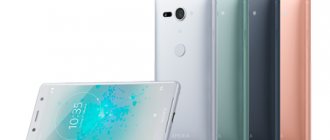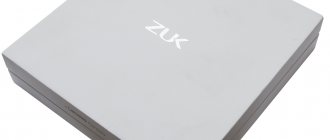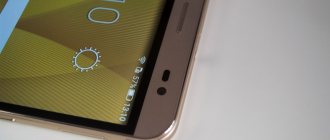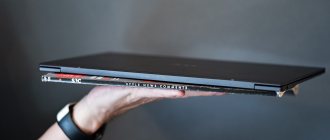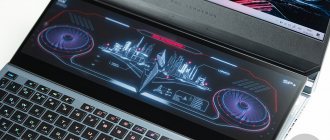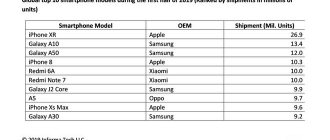The ZUK brand is a subsidiary of Lenovo: just look at the box, where the inscription “a Lenovo company” is eloquently displayed. Chinese manufacturers' low-cost subsidiary brands have been appearing quite often lately. For example, Fly acquired the Wileyfox brand, Huawei has Honor, and ZTE has Nubia. Lenovo joins this company with its ZUK.
True, there was a little confusion with the sale of devices of this brand on the territory of the Russian Federation. As Gleb Mishin, vice president and general director of Lenovo in Russia, CIS countries and Eastern Europe, reported on his Facebook page, at the moment Lenovo has not certified a single ZUK model in the Russian Federation. The official start of sales of devices in Russia is scheduled for spring of this year. So far, ZUK smartphones are coming to us through various online stores, which Lenovo, judging by Mishin’s post, is not too happy about.
What does it mean? Let’s explain it in simple terms: now purchasing a ZUK smartphone is comparable to purchasing some unnamed device. In the event of a defect or breakdown, claims can only be made to the store where the purchase was made.
Meet ZUK Z1 - the first smartphone of a new brand
On paper, the ZUK Z1 looks like a very interesting offer: for 23 thousand rubles the user gets a lot of things.
⇡#Technical characteristics
| (Lenovo) ZUK Z1 | ASUS Zenfone 2 (ZE551ML) | Sony Xperia M5 | |
| Touch screen | 5.5 inches, 1080 × 1920 pixels, IPS; Capacitive, up to five simultaneous touches | 5.5 inches, 1080 × 1920 pixels, IPS; Capacitive, up to ten simultaneous touches | 5 inches, 1080 × 1920 pixels, IPS; Capacitive, up to ten simultaneous touches |
| Air gap | No | No | No |
| Protective glass | Corning Gorilla Glass 3, with oleophobic coating and polarizing filter | Corning Gorilla Glass 3, with oleophobic coating and polarizing filter | Yes (manufacturer unknown), with oleophobic coating and polarizing filter |
| CPU | Qualcomm Snapdragon 801 MSM8974AC: four Krait-400 cores, 2.46 GHz; ARMv7 instruction set; support for 32-bit computing; Process technology: 28 nm HPm | Intel Atom Z3580: four cores of Tangier architecture (x86-64), frequency 2.33 GHz; support for 32-bit and 64-bit computing; process technology: 22 nm | MediaTek helio X10 MT6795: eight cores ARM Cortex-A53, frequency 1.95 GHz; ARMv8-A instruction set; support for 32-bit and 64-bit computing; ARM big.LITTLE technology; process technology: 28 nm |
| Graphics controller | Qualcomm Adreno 330, 578 MHz | Imagination Technologies PowerVR Rogue G6430, 533 MHz | Imagination Technologies PowerVR Rogue G6200, 500 MHz |
| RAM | 3 GB LPDDR3 | 4 GB LPDDR3 | 3 GB LPDDR3 |
| Flash memory | 64 GB (54.7 GB available to the user) No memory card slot | 32 GB (25.5 GB available to user) + MicroSD + 5 GB cloud storage ASUS WebStorage | 16 GB (10.9 GB available to user) + microSD |
| Connectors | 1 × USB Type-C 3.0 1 × 3.5mm headset jack 2 × Nano-SIM | 1 × micro-USB 2.0 1 × 3.5 mm headset jack 1 × microSD (SDHC/SDXC) 2 × Micro-SIM | 1 × Micro-USB 2.0; 1 × 3.5mm headset jack; 1 × microSD; 1 × Nano-SIM |
| cellular | 2G/3G/4G Two SIM cards in Nano-SIM format | 2G/3G/4G Two SIM cards in Micro-SIM format | 2G/3G/4G One SIM card in Nano-SIM format There is a version with support for two SIM and LTE |
| Cellular connection 2G | GSM/GPRS/EDGE 850/900/1800/1900 MHz | GSM/GPRS/EDGE 850/900/1800/1900 MHz | GSM/GPRS/EDGE 850/900/1800/1900 MHz |
| Cellular 3G | DC-HSPA (42 Mbps) 850/900/1900/2100 MHz | DC-HSPA (42 Mbps) 850/900/1900/2100 MHz | DC-HSPA+ (42 Mbps) WCDMA 850/900/1900/2100 MHz |
| Cellular 4G | LTE Cat. 4 (150 Mbit/s, 50 Mbit/s); FDD LTE: band 1, 3, 7 TDD LTE: band 38, 39, 40, 41 | LTE Cat. 4 (150 Mbit/s, 50 Mbit/s); FDD LTE: band 1, 2, 3, 4, 5, 7, 8, 9, 17, 18, 19, 20, 28, 29 TDD LTE: 38, 39, 40, 41 | LTE Cat. 4 (150 Mbit/s, 50 Mbit/s); FDD LTE: band 1, 3, 5, 7, 8, 20 |
| WiFi | 802.11a/b/g/n/ac 2.4/5 GHz + Wi-Fi Direct | 802.11a/b/g/n/ac 2.4/5 GHz + Wi-Fi Direct | 802.11a/b/g/n 2.4/5 GHz + Wi-Fi Direct |
| Bluetooth | 4.1 | 4.0 | 4.1 |
| NFC | No | Eat | Eat |
| IR port | No | No | No |
| Navigation | GPS, A-GPS, GLONASS, BeiDou | GPS, A-GPS, GLONASS | GPS, A-GPS, GLONASS, BeiDou |
| Sensors | Illumination, proximity, accelerometer/gyroscope, magnetometer (digital compass), pedometer | Illumination, proximity, accelerometer/gyroscope, magnetometer (digital compass) | Proximity, accelerometer/gyroscope, magnetometer (digital compass) |
| Fingerprint's scanner | Eat | No | No |
| Main camera | 13 MP (4160 × 3120), autofocus, optical stabilization system, dual LED flash | 12.6 MP (4096 × 3072), PixelMaster technology, f/2.0 aperture, autofocus, LED flash | 21.2 MP (5312 × 3984), Sony Exmor Rs matrix with back illumination; Hybrid autofocus, LED flash |
| Front-camera | 8 MP (3264 × 2448), no autofocus, no flash | 4.9 MP (2560 × 1920), no autofocus, no flash | 12.6 MP (4096 × 3072), autofocus, no flash |
| Nutrition | Non-removable battery: 15.58 Wh (4100 mAh, 3.8 V) | Non-removable battery: 11.4 Wh (3000 mAh, 3.8 V) | Non-removable battery: 9.88 Wh (2600 mAh, 3.8 V) |
| Size | 156 × 77 mm Case thickness 8.9 mm | 152 × 77 mm Case thickness 10.9 mm | 145 × 72 mm; Case thickness 7.6 mm |
| Weight | 175 g | 170 g | 143 g |
| Water and dust protection | No | No | IP65 and IP68 Up to half an hour in fresh water at a depth of up to one and a half meters |
| operating system | Android 5.1.1 Lollipop Shell CyanogenMod 12.1 | Android 5.0 Lollipop ASUS ZenUI shell | Android 5.0 Lollipop Sony's own shell |
| Current price | 23,690 rubles | 23,490 rubles | 27,790 rubles |
| ZUK Z1 – information about the system and technical stuffing according to the CPU-Z application | ||||
Lenovo ZUK Z1 review
We think everyone is already very familiar with the flagship killer according to OnePlus. The niche turned out to be interesting for manufacturers, and some companies wanted to release their own variations of such discounters. One of the most successful attempts seems to have come from Lenovo, and the Zuk brand with its Z1 began to gradually capture the minds of geeks. All the details are in our video!
The smartphone feels quite large, but how could it be with a 5.5-inch display and a 4100 mAh battery. At first it seemed that the glossy plastic of the back cover would cause the device to slip out of your hand, but so far no problems have been noticed, and the only complaint about this very back cover is that it is too dirty.
The appearance of the smartphone makes us remember a number of modern Chinese flagships from Meizu or Xiaomi, and the iPhone, and a scattering of smartphones from mother Lenovo. However, it is quite problematic to blame any of the manufacturers for this. A rectangle with rounded edges - in Africa it is also a rectangle with rounded edges. And dealing with borrowings is the job of armies of lawyers and courts.
The smartphone screen is 5.5 inches, which has become traditional and no longer seems so impressive. The user will be greeted by 2,073,600 screen pixels, but at such a diagonal Full HD is quite sufficient resolution. Moreover, loading the Qualcomm Snapdragon 801 with a higher resolution picture, although it is still quite vigorous, but still not always top-end, would be a reckless activity.
Together with the processor, as much as 3 gigabytes of RAM work, and this volume will definitely be enough for a number of upcoming game announcements. The processor is not new to the market, and therefore applications will not have problems optimizing for it. And there shouldn’t be any problems with overheating either.
The main camera in the smartphone is 13 megapixels; it only works if the sun is shining or there are a lot of electric lamps; in other situations, the module starts making mistakes with white balance or exposure. For social networks and the like, the frames taken with the Zuk Z1 camera will naturally be enough to spare, but in general I would like to hope that the craftsmen will finalize the software part responsible for photography, and the camera can not only be mentioned, but also praised.
If we draw parallels with OnePlus 2, then the Z1 still has the same 2 trendy additions: a fingerprint scanner and USB Type-C. The fingerprint scanner turned out to be very fast; its operating speed is identical to that of the iPhone 6 Plus, for example, although it does not reach the new generation of Touch ID. Type-C pleased us with the full speed of USB 3.0, so files can be uploaded to the 64 gigabyte memory (alas, non-expandable) very quickly.
A 4100 mAh battery will definitely be enough for a day and a half of work; with infrequent games, a couple of hours of phone calls and several hours of music, you can even count on a couple of days of battery life. This is affected by the volume of the battery itself, and the presence of CyanogenMod version 12.1 inside - Android “tuning” was done well, which affects the battery.
Otherwise, the Zuk Z1 is an absolutely typical device for the market, so there is practically no point in mentioning support for Wi-Fi 802.11 b/g/n/ac, Bluetooth 4.1, LTE, GPS and GLONASS. After all, we are talking about a modern smartphone, so describing such characteristics seems somewhat outdated. Now, if only this was a washing machine... No one is surprised by two SIM cards in a smartphone coming from the Middle Kingdom.
For another variation of the “flagship killer”, the Zuk Z1 turned out to be very interesting. Among the “chips” it is worth noting the presence of a full-fledged USB Type-C, 64 gigabytes of memory by default, normal support for LTE and two SIM cards. At a price of $330 as a competitor to the same OnePlus 2, the Lenovo Zuk Z1 is quite suitable.
Make a wish on JD.ru - choose any gift from the JD Collection up to $300 and win it here! Pre-order the ZUK smartphone at the market-best price of $229.99 (the price will decrease on the day of sales). Discounts up to 80% in the New Year sale from JD.ru!
⇡#Appearance, ergonomics, fingerprint scanner
Mid-price smartphones are often very similar in appearance to each other. The main thing in them is not the image, but the maximum number of options for little money. ZUK Z1 is a typical representative of this family: outwardly it is completely unremarkable. One can only complain about some similarities with the iPhone, but we are already so accustomed to this that we did not even immediately pay attention to it.
ZUK Z1 – front panel
ZUK Z1 turned out to be quite large. The side frames around the large screen are of standard width - about three millimeters on each side. The screen occupies only 69% of the front panel area - there is quite a lot of unused space on the front, which increases the size of the gadget. Using the Z1 with one hand is possible, but you will have to try, it is a really large gadget. It weighs 175 grams. The thickness of the case is quite standard - 8.9 millimeters.
ZUK Z1 – front panel
At the top of the front panel there is a front camera lens and a speaker grille. At the bottom is a rectangular Home key. On either side of it are touch-sensitive, but quite physical, “Back” and “Menu of open applications” keys.
ZUK Z1 – hardware key at the bottom of the front panel
A fingerprint sensor is integrated into the Home button, which can be used to unlock the device. It works quite correctly: the device quickly wakes up after pressing the device with a finger, the percentage of errors is minimal. To add a new fingerprint, you need to touch the sensor about twenty times; up to five fingerprints are stored in memory.
| ZUK Z1 – setting up the fingerprint scanner | ||||
There is also a separate power key on the right side, next to the volume buttons. The decision to use two buttons to unlock the device can be explained by an attempt to please everyone at once: not everyone will want to use a fingerprint scanner, and in general this is a matter of habit. The keys have a couple of additional functions: long pressing the central key launches the Google Now assistant, and long pressing the side key launches a context menu with which you can restart your smartphone, select a sound profile, or activate airplane mode. In addition to two hardware keys, to turn on the device there is a software option that allows you to “wake up” the gadget by tapping the display twice. I do not like? It can be disabled.
ZUK Z1 – side with volume and lock keys
The interfaces of the ZUK Z1 are located in a completely standard way: a 3.5 mm audio jack for connecting a wired headset is placed on the top end, and a USB Type-C port is placed on the bottom. We talked about this standard in our review of Google Nexus 6P – it only recently reached mobile devices; We recommend that you read the review. Next to the USB interface there is a slot for an external, moderately loud speaker.
| ZUK Z1 – interface layout | ||
The body of the device is metal, non-separable. The back panel is matte, so the device does not slip out even from wet hands. The “back” of the device is rounded, pleasant to the touch, and not very easily soiled – “fingers” remain on it, but they are invisible to the naked eye and are easily erased.
ZUK Z1 – rear panel
The functional elements on the back panel are the rear camera lens and dual LED flash. The device is assembled well - we did not notice any play or creaks during testing.
ZUK Z1: expressive photos
On the back of the ZUK Z1 there is a 13-megapixel camera with optical image stabilization. In daylight, the ZUK delivers solid results. However, the images have slightly reduced detail.
In low light conditions, the dual LED flash mounted on the back of the smartphone is activated. However, pictures taken in poor lighting cannot be very pleasing. The main camera is capable of shooting video in Full-HD resolution, but the ZUK Z1 smartphone does not support 4K, but can record slow motion in 1080p format at 60 frames per second. For selfie lovers, there is an 8-megapixel front camera on board.
⇡#Display
The smartphone has a 5.5-inch display with Full HD resolution. Its pixel density is quite high - a little more than four hundred dots per inch, which is more than enough for comfortable use of the device. The pixel does not hurt the eyes either when watching a video or when reading - pictures look detailed, fonts are sharp. But the display has both advantages and disadvantages.
For example, it doesn't have very wide viewing angles. As soon as you look at the screen from any large angle, the contrast noticeably drops, and the black color becomes dark gray. This is a fairly common drawback in inexpensive mobile matrices.
The touch surface supports up to five simultaneous clicks and easily detects gestures. The device may not respond correctly to presses while wearing loose gloves, but on the second or third attempt it will definitely work to perform a simple action - say, answer an incoming call.
The ZUK Z1's screen is very bright. The maximum luminosity of the white field is 561 cd/m2. Not every flagship smartphone can boast such a reserve of brightness. The information on the display is clearly visible in any lighting conditions, even in direct sunlight. The standard oleophobic coating, a polarizing filter, and the absence of an air gap between the glass and the matrix also help with this. The minimum white luminosity is 18 cd/m2; using a smartphone in the dark is also quite comfortable. The device is equipped with a light sensor - it can independently set the screen backlight level that is convenient for working in different conditions and does this quite correctly.
The smartphone display also boasts a high contrast ratio. When measured on images filled with half white and half black, it was 1383:1. An excellent indicator - most competitors have significantly less.
ZUK Z1 – grayscale color temperature
The white balance of the Z1 screen is evenly distributed - it does not “jump” during transitions between tones. The grayscale color temperature is 7250 K, only slightly higher than the reference value of 6500 K. The picture is a little colder than necessary, but this is not noticeable at all. The smartphone does not have the ability to programmatically adjust the color temperature.
| ZUK Z1 – gamma curve of grayscale (left) and color components (right) in comparison with the reference curve (indicated by a dotted line on the graphs) | ||
We talked about the shortcomings - here's another one: the ZUK Z1 screen is configured not without flaws. For example, the gamma curve of gray color is slightly raised in the middle part, that is, in fact, the image will not be so contrasting. The same goes for blue and green colors - there is a tendency to overexposure. The gamma curve of red, on the contrary, is slightly lower in the upper part relative to the reference curve - bright shades of red are displayed somewhat darker than they should be.
ZUK Z1 – smartphone screen color gamut (white triangle) compared to the sRGB reference space (black triangle)
The Z1 display's color gamut is significantly wider than the sRGB reference color space. And this, let us remind you, is not very good, since most of the content is “tailored” specifically for sRGB. As a result, the colors on the screen look too saturated and unnatural. Unfortunately, the smartphone does not have different color profiles that allow you to change the nature of color rendering. Overall, the display is good, and if it weren’t for poor calibration and viewing angles, it would be excellent.
⇡#Hardware and performance
The creators took an extremely original approach to choosing a system-on-a-chip for the Z1. They clearly wanted to make the device powerful enough so that it could solve any problem, but at the same time save money. This is probably why its “heart” became... the Qualcomm Snapdragon 801 platform! Yes, yes, the same one that was the flagship a couple of years ago. We haven’t seen it in smartphones and tablets for about a year now – and, frankly, we can easily consider it obsolete. It is built on four old, but very powerful for its time, Krait-400 cores (Qualcomm’s own design) with the ARMv7 instruction set and without support for 64-bit computing. The frequency of the cores is high and by modern standards - 2.46 GHz. The Adreno 330 module, operating at a frequency of 578 MHz, is responsible for rendering graphics. The platform was made using a 28 nm process technology.
The smartphone has a lot of RAM, like a flagship - three gigabytes of LPDDR3. It’s also a shame to complain about the amount of built-in flash memory - 64 GB, but there is no way to increase it - there is no slot for memory cards in the ZUK Z1. It remains to be advised to use cloud services.
Despite the fact that the platform in the Z1 is old, the ZUK shows very decent results in synthetic tests. For example, in AnTuTu Benchmark 5 he scored 48 thousand parrots, which is more than many of his “classmates” - the legendary Snapdragon 801 still has gunpowder in its flasks. The smartphone works very smoothly and smoothly. We did not notice any slowdowns during testing. It quickly switches between applications, smoothly renders operating system animations - everything is as expected. In terms of performance when performing everyday tasks, the device is completely fine.
With resource-intensive applications, the ZUK Z1 is also doing quite well, by and large. The gadget will begin to think only if you turn up the graphics settings in some newfangled “heavy” toy to the maximum - it is no longer designed for this. At the same time, the smartphone does not freeze tightly, the picture does not twitch, except that the FPS sags to not very comfortable, but still acceptable values. The smartphone copes with other applications perfectly well.
The device easily displays videos in the screen’s native Full HD resolution, and the built-in multimedia player knows many different audio and video formats, including FLAC. In general, choosing the Snapdragon 801 as a platform seems to be a wise decision - the chip today is probably sold for almost nothing, and its power is still good.
Hardware platform
Zuk Z1 at one time came out with the top-end Qualcomm Snapdragon processor. Zuk Z2 couldn't have turned out any differently. The platform is Qualcomm Snapdragon 820 (MSM8996). It is equipped with four cores built on the Kryo architecture, which are organized into two blocks of two cores. The first two are for performing resource-intensive tasks with frequencies up to 2.2 GHz, and the other two are for energy saving with frequencies up to 1.6 GHz. The Adreno 530 video core is 40% more productive than the Adreno 430 used in the Snapdragon 810. The amount of RAM is 4 GB LPDDR4 (a little more than 2 GB is available after switching on). Built-in memory is 64 GB, with 53 GB available to the user.
The high-performance Qualcomm Snapdragon 820 platform in synthetic tests shows results at the level of 2016 flagships. Zuk Z2 is perfect as a gaming smartphone.
For some reason, the new Asphalt Xtreme slowed down for me at maximum settings. I hope this will be fixed in the next game update. There were no problems with other games, such as NOVA 3 and Space Marshals 2.
When playing games, the phone heats up, which is felt on the back side near the camera. At the same time, the heating is not strong, but the sensor data can argue with me.
The operation of the wireless interfaces did not raise any questions. Finding satellites even without using mobile Internet takes a matter of seconds.
There are no complaints about the speaker and microphone. The multimedia speaker is loud, but there is only one, and it is located so that it can easily be covered with your hand during the game.
⇡#Communication and interfaces
A smartphone can pleasantly surprise you in terms of communication capabilities. As befits a Chinese device, it can work with two nanoSIM cards. True, there is only one radio module in the device: if a voice call occurs on one of the cards, the second one becomes temporarily unavailable - this is called Dual SIM Dual Standby. Only one card can work with third- and fourth-generation networks; you can select in which networks which card will function in a special item in the smartphone settings menu.
ZUK Z1 – SIM card settings
An important clarification regarding LTE: the ZUK Z1 does not yet support the 20th band, which is very important for Russia. Because of this, for some operators, 4G on the device may not work correctly, periodically disappear, or not work at all. In our practice in Moscow and the MegaFon region, LTE on the Z1 worked quite well. Apparently, the device’s support for the third and seventh bands was sufficient. Gleb Mishin in his post mentioned the absence of the 20th band and said that “official sales of ZUK will begin in Russia in the spring, starting with a new product line, when the devices will be “tailored” for the Russian market.” Perhaps this just means that the missing range will appear in the Russian version of Z1.
The maximum theoretical speed of information reception via mobile networks of the ZUK Z1 is limited by the LTE Cat standard. 4 – 150 Mbit/s for download and 50 Mbit/s for upload. It is quite convenient to talk on this smartphone: the speaker has a decent volume reserve, and the interlocutors did not complain about poor audibility.
The set of wireless interfaces in the device is completely standard for the middle class: the device supports dual-frequency Wi-Fi of all common protocols and Bluetooth 4.1. There is no NFC or IR port in the Z1. The device navigates the terrain using a radio module that is trained to see GPS, GLONASS and BeiDou satellites. It works well - the location is determined quite quickly and accurately. Half a minute after the test was launched, the device detected ten satellites and was guided by eight of them, while the navigation error radius was minimal - about four to five meters. The gadget is suitable for the role of a navigator.
| ZUK Z1 – AndroiTS outdoor test results | ||
Data transfer to the PC and charging is carried out, as we said, using the new USB Type-C standard. Within this format, the capabilities of any USB standard can be implemented: from 2.0 to 3.1, that is, the presence of a Type-C connector in the device does not guarantee high data transfer speeds. However, ZUK Z1 owners are lucky - it provides the USB 3.0 standard with a maximum theoretical data transfer rate of 5 Gbps.
⇡#Camera
The set of cameras in the smartphone is quite standard, but with a small surprise in the form of an 8 megapixel front camera. It shoots very well in daylight and copes well with artificial light - you can use it to talk to video even in dark rooms. True, in this case the picture becomes noisy, but the facial features remain quite distinguishable.
The rear camera is equipped with a 13 megapixel sensor, autofocus, optical stabilization system and dual LED flash.
ZUK Z1 – main camera
This is an ordinary mobile camera, among its “classmates” it stands out only for its optical stabilization - such luxury is not usually found on middle-class smartphones. In daylight, the camera allows you to take quite good pictures, with decent detail and natural color rendition. When shooting indoors, the picture becomes excessively grainy, and the clarity drops noticeably. Colors fade in low light - as with many inexpensive mobile cameras. In the dark, it is better not to shoot with the ZUK Z1 camera at all or use the flash.
ZUK Z1 – examples of photos taken with the main camera
View all images (5)
Cameras
ZUK Z1 has two cameras. The main one is based on a Sony IMX214 sensor (13 megapixels) with a two-axis optical stabilization system and a dual-LED flash; the front camera is based on an OV8865 sensor (8 megapixels). More technical information about cameras can be found on the website, but we’d rather take a look at sample images.
It can be seen from them that on the ZUI firmware that was current at the time of writing the review, the device shoots averagely by flagship standards; we are clearly not looking at a competitor to the LG G4, iPhone and Samsung S6 line devices. The process of focusing and saving images occurs very quickly, but periodically autofocus misses (even during the day), the quality of photographs indoors noticeably drops and decreases even more critically in the evening.
Video shooting is also lame so far. It seems that the software component and processing algorithms are failing, but there is a possibility that they will work on this in new firmware.
Front camera without any unpleasant surprises.
⇡#Autonomous work
ZUK Z1 stands out from its peers with a very capacious battery - 15.58 Wh (4100 mAh, 3.8 V); At best, competitors get a 3000 mAh battery. There is only one bad thing: the user does not have access to the battery, and it is impossible to replace it yourself. ZUK does not have service centers in Russia yet, so this could become a problem.
ZUK Z1 – energy consumption scenarios
There are no special modes for saving battery resources in the Z1. The user can choose only one of three energy consumption options: economical, balanced and productive. At the same time, there are absolutely no possibilities for personalizing these modes. All tests presented in this material were done in a balanced mode - in it the user can count on the device to work for up to a day and a half with active use; In standby mode, virtually no energy is consumed. A full charging cycle takes just over two hours – fast charging is carried out using proprietary Qualcomm Quick Charge technology.
In our standard test of continuous HD video playback at maximum screen brightness, with an active Wi-Fi connection and data updating in the background, the device lasted almost eleven hours. The result is truly amazing! ZUK Z1 is one of the most durable Android smartphones. With it you can safely leave the house without a charger and without an external battery.
How to flash ZUK Z1
Installation and updating can be done with your own hands using programs for firmware, free of charge, the links contain both original, that is, stock, official (not modified), and custom firmware, that is, alternative, all with instructions.
- First you need to download the firmware by selecting one of the options below. Along with it in the archive is the necessary set of programs (TWRP and others).
- Then extract the file “instructions_rootgadget.txt” from the archive. Using the archiver program...
- The firmware file contained in the zip archive must be downloaded to a memory card or smartphone memory.
- For other information and sequence of actions, see the text instructions.
ZUK Z1 firmware
Choose what you like, but it is best to download the most modern versions, they have more optimized energy consumption and other joys of life.
- Android Pie 9.0 is a flagship OS, one might say, but still a little unfinished. URL: uptruefile.info/android9pie
- 8.0 Oreo is an excellent option, with a minimum of bugs and rich functionality, but version 9 is certainly better. URL: uptruefile.info/android8oreo
- 7.0 Nougat is a stable version in all respects, it works even on low-power hardware. URL: uptruefile.info/android7nougat
- 6.0 Marshmallow - versions 5 and 6 are already really old, although they were once the pinnacle of progress. But if you switch to them from versions 3 or 4, then of course the difference is very noticeable. URL: uptruefile.info/android6
- Android 10 URL: uptruefile.info/android10
- Android 11 URL: uptruefile.info/android11
